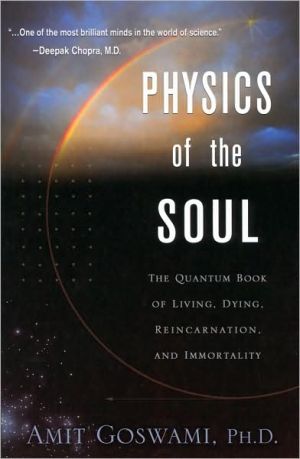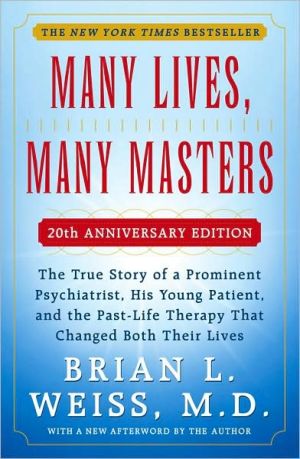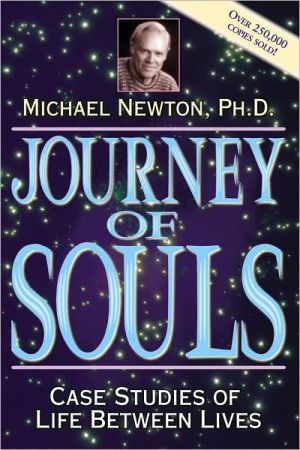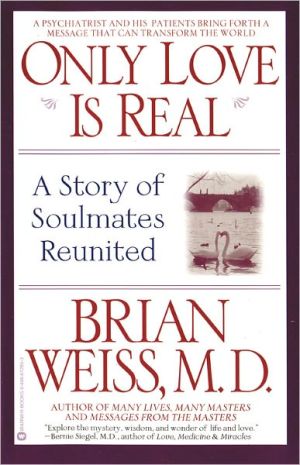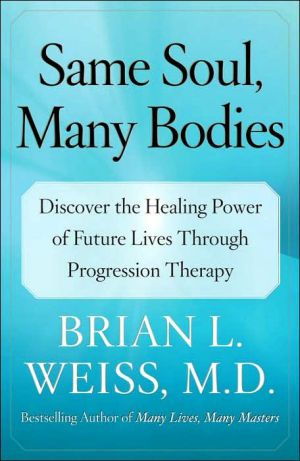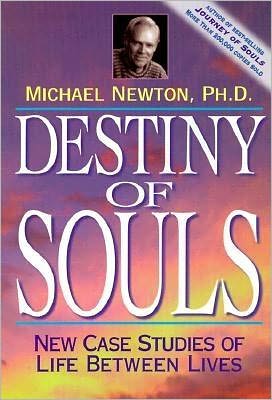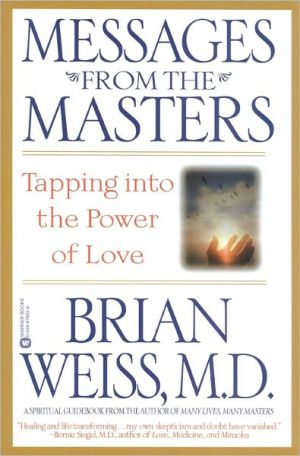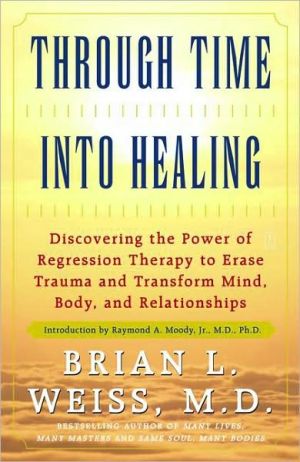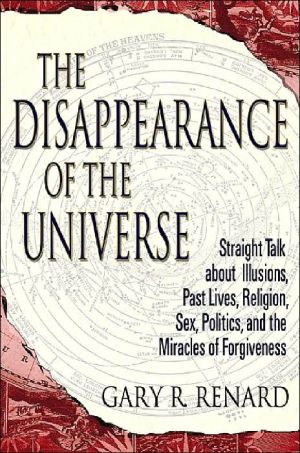Physics of the Soul: The Quantum Book of Living, Dying, Reincarnation, and Immortality
Can the bizarre and probabilistic world of quantum physics be used to prove the existence of the soul and its immortality? In Physics of the Soul Dr. Amit Goswami details how cutting-edge science might be used to answer questions that religions have grappled with for millennia. He proposes that a "quantum monad" is involved in reincarnation, and draws upon UFO sightings, past-life regression, ghosts and angels to broaden the applicability of his ideas.\ First published in 2001, Physics of the...
Search in google:
At last, science and the soul shake hands. Writing in a style that is both lucid and charming, mischievous and profound, Dr. Amit Goswami uses the language and concepts of quantum physics to explore and scientifically prove metaphysical theories of reincarnation and immortality.In Physics of the Soul, Dr. Goswami helps you understand the perplexities of the quantum physics model of reality and the perennial beliefs of spiritual and religious traditions. He shows how they are not only compatible but also provide essential support for each other. The result is a deeply broadened, exciting, and enriched worldview that integrates mind and spirit into science.One of today's pioneering thinkers in science and spirituality, Dr. Goswami taught physics for 32 years, was a professor of Theoretical Science at the University of Oregon, and is currently senior resident researcher at the world-renowned Institute of Noetic Sciences. He is an advocate of "monistic idealism," the philosophy that defines consciousness, not materiality, as the primary reality. Publishers Weekly Can the bizarre and probabilistic world of quantum physics be used to prove the existence of the soul and its immortality? In Physics of the Soul: The Quantum Book of Living, Dying, Reincarnation, and Immortality, Amit Goswami (The Self-aware Universe; Quantum Creativity; etc.) details how cutting-edge science might be used to answer questions that religions have grappled with for millennia. The author hypothesizes that a "quantum monad" is involved in reincarnation, and draws upon UFO sightings, past-life regression, ghosts and angels to broaden the applicability of his ideas. New Age buffs should find this book appealing. (Sept.) Copyright 2001 Cahners Business Information.
Chapter One \ \ \ From Death to Immortality\ \ \ What is death? This seems easy to answer. Death is when life ends; it is the cessation of life. But do we know what life is? Do we know what its cessation means? Those questions are not so easy to answer, at least not in science.\ Most people are little interested in scientific definitions of life and death. In 1993, after my book came out proposing a new scientific paradigm for the nature of reality, a science based on the primacy of consciousness, I was on a call-in radio show. The first question was not on the nature of reality or consciousness. It was, is there life after death? At first, I was surprised; then I realized that this is the ultimate question about reality for many people.\ Even children want to know. In a letter to God, a child wrote, "Dear God, what happens when we die? I don't want to do it. I just want to know what it is like."\ What happens after death? In the past, this was a question you would take to your local priest or minister or guru or mullah or rabbi or Zen master or shaman. This was not regarded as a question of science at all. Science in those days dealt with mundane aspects of the world; religion was the source of answers to questions that mattered more intimately to people: how to live life, what happens after death, how to know God, and such.\ Not that one always got answers. A Zen aspirant went to a Zen master and asked, "What happens after death?" The Zen master replied, "I don'tknow." The practitioner was surprised. "But you are a master!" he protested. "But I am not a dead master," came the answer.\ However, many gurus of various religions were often less hesitant to provide answers. And the answers, for the most part, were simple (at least, those from organized religions). God is the ultimate emperor of the world, which is divided into good and evil. If you belong to the good, you end up after death in Heaven, a very desirable place of peace and joy. If, however, you follow evil, death thrusts you into Hell, engulfing you in fire and brimstone and suffering. The message of religion was "be good." And if being good is not rewarded here on Earth, it will be rewarded after death. Alas! In this sophisticated scientific age, this kind of answer does not satisfy.\ So are you going to get sophisticated and satisfying answers in this book? I hope so. The answers are based on a new physics called quantum physics, which when grounded in the philosophy of primacy of consciousness, gives us a visionary window through which flow gale winds of new answers to age-old questions. The questions and answers regarding what happens after death are only the latest of the discoveries of this new science. Read on.\ \ \ What Survives?\ Who are you after death? Clearly, the after-death you could not be a physical or corporeal entity. So the idea of an incorporeal soul is popular. It is your soul that survives the death of your body, you are told. And after death, the soul goes either to Heaven or to Hell, depending on how you fare on judgment day.\ The pictures that many people make of what they expect Heaven to be like suggest that even in Heaven they very much expect to have their egos intact, as in Hollywood movies. To them, the ego is the soul. However, objections can be raised against such a belief.\ How do we get our ego-identity? Clearly, our experiences as we grow up shape the ego. Memories of these experiences most probably are preserved in the physical brain. Moreover, experiences alone (nurture) are not the whole of ego-development; it seems logical that our genetic endowment (nature) also plays a role. But both genetic and brain memories are physical. With the demise of the body and the consequent decay of these physical memories, can the ego function?\ Another argument against the soul as ego has been raised by the psychologist Charles Tart. Tart (1990) points out that the body and the brain are stabilizing influences for our identity. In dreaming, for example, we lose awareness of our physical body, and look what happens. Our identity can shift from one dream-body to another many times during the dream; there just isn't much stability in who we identify with. Similar things happen with sensory deprivation and psychedelic drugs. The normal, stable ego-identity that we experience in our waking awareness disappears in these altered states of consciousness. Tart thinks that this may indicate what the altered state of consciousness that we attain after death is like, unless there are other kinds of stabilization processes that we don't know about.\ So the nature of the soul, the nature of what survives at death, is a difficult and controversial question. It gets even more controversial, even more puzzling, when we ponder the continuum pictures—life and death as a continuum—of many cultures. Not only does something survive death, but that something returns in another body in another birth, and on and on the process goes.\ \ \ Reincarnation\ The picture of a soul surviving in either Heaven or Hell after death is more or less the picture in popular Judeo-Christian cultures. Other cultures have it somewhat differently. Sometimes—for example, in Islam—the differences are minor. But sometimes the differences in the view of after-death reality are quite radical. Hindus in India, Buddhists in Tibet and elsewhere (although in Buddhism the concept of soul is very subtle), and many people of Chinese and Japanese ancestry even outside Buddhism believe in the soul and in Heaven and Hell, but for them a sojourn in Heaven or Hell is only the beginning of the journey. Heaven and Hell, in these cultures, are temporary residences, after which the soul must once again return to Earth. How long you stay in your temporary Heaven or Hell depends on your karma, a concept of cause and effect that comprises a ledger of good and evil but with one major difference.\ Doing good accrues you good karma, and bad deeds increase bad karma in your karmic ledger—just as in Christianity. Bad karma is unwelcome, of course; for example, many Chinese fear that if their earthly deeds are really bad, they will be born as rats or even as worms in the next life. But even good karma does not stop the wheel from turning. However much good karma you accrue, you cannot stay in heavenly perfection forever; you always come back to earthly imperfection. Thus enters the subtle idea that even good karma is not good enough. Even then you remain tied to the wheel of karma, the cycle of recurring reincarnation. And the karmic wheel is seen as propelling the vehicle of suffering.\ What can be better than accruing good karma, doing good in all your earthside actions and experiences? The Hindu and Buddhist idea is that there is an ultimate, perfected way of living, the discovery of which gets you off the wheel of karma. Hindus call this moksha, literally meaning liberation; and Buddhists call it nirvana, literally translated as extinction of the flame of desire.\ We can use philosophy to explain these differences between the Judeo-Christian and Hindu/Buddhist views in what happens after death. In one philosophy, the specific model of after-death reality that a culture develops depends on whether the culture is materially rich or poor. The purpose of religion is to entice people to live in the good rather than in the evil. If the culture is materially poor, people live in hope of enjoying the good life after death. If they knew about reincarnation, they would not hesitate to be bad once in a while and to take the risk of temporary hell. There is always the next life for being good. So the idea of eternal hell is important to keep them in line; they already know hell, they don't want an eternity of it. In affluent societies, on the other hand, the idea of reincarnation can be told.\ In affluent societies, people live in a class system in which most people are middle class. If you are middle class, then the worst thing that can happen to you is to become poor. Then the threat of reincarnation works since bad karma not only begets hell, it also begets a lesser life form (a lower class, for example) in the next incarnation. Such was the case with the Hindu caste system in affluent ancient India, where the idea of reincarnation flourished. This is now changing in India; most people are now poor there and the idea of reincarnation is no longer all that popular. On the other hand, today's Western societies with increased affluence have increasingly become class systems. And no wonder the idea of reincarnation is now taking hold in these societies.\ It makes sense. In After Death 100, you learn the basic concepts, God, good and evil, soul, heaven and hell. In After Death 300, you get the idea of reincarnation, the wheel of karma. There you ask questions that you couldn't think of in the one-hundred-level course. If there is life after death, why not life before life? Why do bad things happen to good people? And the best one, how can a truly just and benevolent God not give everyone the good life of Heaven?\ Compared to these courses, the idea of liberation is a five-hundred-level graduate course. You enter it only after you have indulged in a lot of "karma-cola." You enter it when you ask questions about the very nature of reality and about your connection to it, when you intuit that you, the world, and God are not separate and independent from one another. You enter it when the whole world of sentient beings becomes your family, and you want to serve your family in a new way.\ The philosopher Michael Grosso has called the recent revival of interest in reincarnation in America "the spontaneous formation of a myth of reincarnation," but it is more than the formation of a myth. I think we have graduated en masse from After Death 100 to the three-hundred-level course. And some of us already ponder taking the graduate course.\ When does the transition to the next-level course take place? The philosopher Alan Watts explained it pretty well. To Watts (1962), the wheel of karma is much like being at a carnival. Initially, as a soul, you are less adventurous. You hold on to the good life when you reincarnate. Only later do you realize that there is a greater learning opportunity in taking the more risky rides—being born as poor (but virtuous) or living a bumpy but creative life. But, even then, the ultimate suffering of boredom catches up with you; the idea of eternal attachment to the karmic wheel will seem dreadful to all of us sooner or later. The filmmaker Woody Allen in Hannah and Her Sisters captures this sentiment perfectly:\ \ \ ... Nietzsche with his theory of eternal recurrence. He said that the life we live, we're gonna live over and over again the exact same way as eternity. Great. This means I'll have to sit through the Ice Capades again. It's not worth it.\ (Quoted in Fischer 1993)\ \ \ When we feel this way, then we can turn to the idea of liberation.\ Notice that both the Christian idea of eternity in heaven and the Eastern idea of liberation, in essence, refer to a stage that we truly can call immortality of the soul—no more birth, no more death. The former (heaven) is only a somewhat simplified version of how we get there—it omits the intermediate steps.\ So don't think that ideas of reincarnation are entirely Eastern, only recently imported to the West. Reincarnation was an accepted part of the Judaism into which Jesus was born. It is held by many scholars that before 553 A.D., Christianity also accepted the idea of reincarnation. In that year, it is said that a decree was passed by the fifth Ecumenical Council against the idea that souls reincarnate, although other scholars think that the council never officially made such a decree. (For a good discussion, see Bache 1991 and MacGregor 1978.)\ Many scholars also think that the division about reincarnation in the West is not a division between West and East but a division between the esoteric and exoteric threads of Western religions. Reincarnation is embraced by Sufis, the esoteric branch of Islam. Hasidic Judaism supports reincarnation, as do the gnostic and other mystical traditions in Christianity (Bache 1991; Cranston and Williams 1984).\ The idea of reincarnation occurs frequently in Western thought outside of any religious context. Beginning with Pythagoras and Plato, people such as David Hume, Ralph Waldo Emerson, Henry Thoreau, Benjamin Franklin, J. W. von Goethe all believed in reincarnation. Goethe wrote:\ \ \ The soul of man is like to water;\ From Heaven it cometh\ To Heaven it riseth\ And then returneth to Earth,\ Forever alternating\ \ (From Song of the Spirits over the Waters,\ as quoted in Viney 1993).\ \ \ And Franklin wrote for his own epitaph when he was only twenty-two:\ \ \ The Body of B. Franklin\ Printer,\ Like the Cover of an Old Book,\ Its Contents Torn Out\ And\ Stripped of its Lettering and Guilding,\ Lies Here\ Food for Worms,\ But the Work shall not be Lost,\ For it Will as He Believed\ Appear Once More\ In a New and More Elegant Edition\ Revised and Corrected\ By the Author (Quoted in Cranston and Williams 1984).\ \ \ The Theosophy movement, in which reincarnation is a basic doctrine, rapidly took hold in the West in the nineteenth century because the seed for accepting reincarnation was already there. More recently, public opinion polls indicate that a substantial number of Westerners, perhaps as large as 25 percent, believe in reincarnation (Gallup 1982). The philosopher C. J. Ducass maintained that "the belief in the continuity in life originates [in children] altogether spontaneously." The data we have of reincarnational-memory recall shows that there are now many such cases in the Western world (Stevenson 1974). If reincarnation is not a culture-bound theme, if it is universal, then it is natural to ask if the idea is scientific.\ \ \ Are Survival and Reincarnation Ideas Scientific?\ Does any of this discussion make sense under the scientific scrutiny of our age? Several decades ago the answer would necessarily have been a resounding no, but not anymore. A primary reason is good data. I referred above to the data concerning reincarnational-memory recall. Much of this data, aspects of which have been verified, is about children recalling their past lives. Much more data has been obtained from what is called past-life regressions: people seem to remember past-life incidents under hypnosis, trauma, drugs, or other special techniques. (For a review, see Cranston and Williams 1984.) And much of the recalled memory has been corroborated. In many cases the possibility of fraud has been eliminated.\ Most importantly, reincarnational-memory recall is not the only data. Near-death experiences—experiences of people who are brought back from clinical death states—corroborate very well the descriptions of after-death reality, at least some phases of it, found in "books of the dead" of ancient cultures. (For a review of books of the dead, see Grof 1994.) Near-death experiencers describe being out of their bodies, going through a tunnel into another world, seeing long-dead relatives, spiritual beings of light, and so forth.\ In the past few decades, science has also begun a timely but unexpected reevaluation of ancient wisdom. Whereas the general trend of science since the seventeenth century has been to evolve toward a material focus, science in the closing decades of the twentieth century began to explore the previously marginalized spiritual arena. In this book I will demonstrate that the aborning new paradigm of science is quite consonant with ideas such as God, soul, heaven, hell, karma, reincarnation—the whole gamut.\ Such ideas are extremely subtle when properly formulated and understood. Our conditioned tendency is to think about them in a crude, materialist manner. For example, most people think of heaven as a place patterned after Earth (witness some of Hollywood's movie depictions). Popular religions often portray it that way, and we fall prey to that mode of thinking from childhood. But clearly, the "other world," if it exists, must be radically different from this one.\ Modern science has pretty compelling support for a monist world—the idea that there is only one substance that makes up reality. If there were a dual world of soul substance, how could such a world interact with the material one? What can mediate such interaction? Clearly, neither soul substance nor material substance can act as the mediator. Also, would not such interaction involve the exchange of energy between the two worlds? If so, the energy ledger of the material world would show occasional excess or deficit, but the truth is, it doesn't. That the energy of the material world is a constant is a physical law—the law of energy conservation. Therefore, the scientific wisdom, rightly, is to avoid interaction dualism (a legacy of the philosopher René Descartes) in our thinking about reality; dualism and science are like oil and water: they don't gel.\ So the old science of the past three centuries taught us that all phenomena are phenomena of things that are made of matter. It is a monism based on the idea that matter is the ground of all being. The new paradigm posits instead a monism based on the primacy of consciousness—that consciousness (variously called Spirit, God, Godhead, Ain Sol, Tao, Brahman, etc., in popular and spiritual traditions), not matter, is the ground of all being; it is a monism based on a consciousness that is unitive and transcendent but one that becomes many in sentient beings such as us. We are that consciousness. All the world of experience, including matter, is the material manifestation of transcendent forms of consciousness.\ The allegory of Plato's cave makes the situation clear. Plato imagined human experience to be a shadow show: We are in a cave strapped into chairs so that we always face the wall on which a light from outside projects the shadows of ideal archetypal forms. We take the shadows as reality, but their source is behind us in the archetypes. And ultimately, light is the only reality, for light is all we see. In monism based on the primacy of consciousness, consciousness is the light in Plato's cave, the archetypes make up the transcendent reality, and the shadow show is the immanent reality.\ Such a monistic view of reality, which I call monistic idealism, is very old and constitutes the basis of all the world's great spiritual traditions, which is why it is sometimes called the perennial philosophy. In esoteric Christianity, the ground of being is called the Godhead, the transcendent archetypal world is heaven, and the world of experience is Earth. In the past, the scientific acceptance of this view was limited because idealists could not explain concepts such as transcendence and self-reference (how the one divides into a subject/self that can refer to itself and object(s) that are separate from itself) in scientifically accessible terms. The new paradigm of a science within consciousness, sometimes called idealist science, began when these concepts gained scientific credibility. This has been the subject of several recent books, including my own (Goswami 1993; Herbert 1993).\ This is genuine progress. Materialism is pure metaphysics; there is no way to verify objectively that everything, including mind and consciousness, arises from matter. The perennial philosophy of old was what we may call experiential metaphysics because great spiritual teachers from all traditions have always claimed to have directly seen that being is grounded in a limitless, transcendent, and unitive consciousness. In contrast, monistic idealism—perennial philosophy in the new context of the science within consciousness—is not only experiential but also experimental metaphysics since, at least in part, its metaphysical ideas are verifiable not only by private individual experiences but also by experiments in the public arena.\ If you grew up in the West's still very materialist culture, your worldview very likely is a strange and confused amalgam of materialism (the supremacy of matter) and Cartesian interaction dualism (the spirit world exists as a separate and independent world made of a nonmaterial substance that somehow interacts with the material world). Not so long ago, people tried to prove the existence of soul by attempting (unconvincingly) to show that a body loses weight upon death in violation of the principle of conservation of energy.\ Even avowed monistic idealists often fall prey to dualistic soul-talk a la Descartes when discussing death and reincarnation. They talk of establishing the validity of ghosts, apparitions, as objects of the same shared physical reality as a chair or a tree. I see a chair because it reflects light to my eyes. Can a ghost, if it is an other-worldly nonmaterial being, emit a signal or reflect light for my senses to pick up? Obviously not. A most important challenge to our science within consciousness is to recast the discussion of the phenomena related to death and reincarnation from the monistic perspective. This is the challenge I take up in this book. If dualist concepts have to be used, we must find explanations that do not violate the laws of science; we must reconcile these concepts within an overall monistic view. This is what I have been able to accomplish.\ \ \ The Soul and the Quantum\ What survives? Does what survives reincarnate in some way that we may call a true continuum—birth-death-rebirth, on and on? During an intense period of research that lasted about a year, I found my answer. There is a "soul" that survives the death of the physical body, and it does reincarnate in another body to form a continuum. Yes, such soul-talk makes sense in a science based on consciousness, but only when we think of the soul in terms of the "quantum."\ The situation is similar to what happened toward the end of the nineteenth century. Physicists found that thinking of matter and light in the old Newtonian way—namely, matter is always localized, traveling in well-defined trajectories, and light is always wavelike, dispersed, capable of being at more than one place at the same time—gave them anomalies and paradoxes. They discovered a new way of thinking—the quantum way.\ (Continues...)\ \ \ Excerpted from Physics of the Soul by Amit Goswami, Ph.D.. Copyright © 2001 by Amit Goswami, Ph.D.. Excerpted by permission. All rights reserved. No part of this excerpt may be reproduced or reprinted without permission in writing from the publisher. \ \ \ \
Prefaceix1.From Death to Immortality12.The Tibetan Book of the Dead Is Correct--It's Our Job to Prove It!213.Nonlocality and Reincarnation: A Cavalier Conversation with My Wife504.The Nonlocal Window: Putting the Tibetan Book of the Dead in Modern Terms595.Is There More to the Story of Reincarnation than Quantum Nonlocality?706.Do We Have More than One Body?947.The Quantum Monad1208.The Complete Story of the Tibetan Book of the Dead1459.From the Ego to the Evolving Quantum Monad: Developing a New Context for Living15910.Death Yoga: Creative Dying18211.Questions and Answers19812.The Physics of Immortality21613.UFOlogy, Immortality, and Evolution236Epilogue: The Nine Lives of the Soul249Glossary255Bibliography269Index281About the Author289
\ Publishers WeeklyCan the bizarre and probabilistic world of quantum physics be used to prove the existence of the soul and its immortality? In Physics of the Soul: The Quantum Book of Living, Dying, Reincarnation, and Immortality, Amit Goswami (The Self-aware Universe; Quantum Creativity; etc.) details how cutting-edge science might be used to answer questions that religions have grappled with for millennia. The author hypothesizes that a "quantum monad" is involved in reincarnation, and draws upon UFO sightings, past-life regression, ghosts and angels to broaden the applicability of his ideas. New Age buffs should find this book appealing. (Sept.) Copyright 2001 Cahners Business Information.\ \ \ \ \ From the Publisher\ "Dr. Amit Goswami is one of the most brilliant minds in the world of science. His insights into the relationship between physics and consciousness have deeply influenced by understanding, and I am deeply grateful to him. Physics of the Soul is both challenging and brilliant." -Deepak Chopra\ "...one of the most original contemporary thinkers and writers in the field of physics and consciousness."..This book is reader-friendly; Goswami makes difficult concepts accessible and exciting." -Stanley Krippner\ \ \
